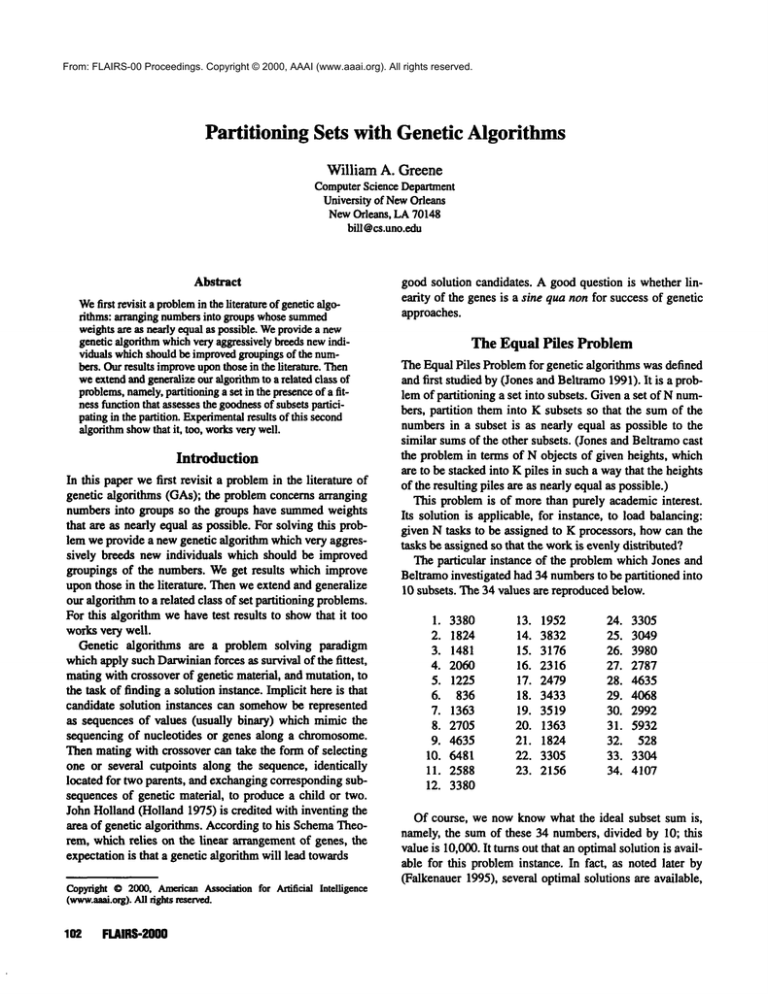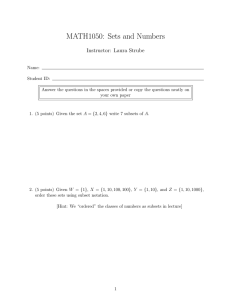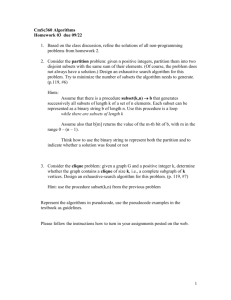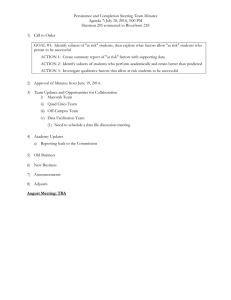
From: FLAIRS-00 Proceedings. Copyright © 2000, AAAI (www.aaai.org). All rights reserved.
Partitioning Sets with Genetic Algorithms
William A. Greene
ComputerScience Department
Universityof NewOrleans
NewOrleans, LA70148
bill@cs.uno.edu
Abstract
Wefirst revisit a problem
in the literature of geneticalgorithms: arranging numbersinto groups whosesummed
weightsare as nearly equal as possible. Weprovidea new
geneticalgorithmwhichvery aggressivelybreedsnewindividuals whichshould be improvedgroupingsof the numbers. Ourresults improveuponthose in the literature. Then
weextendand generalizeour algorithmto a related class of
problems,namely,partitioninga set in the presenceof a fitness functionthat assessesthe goodness
of subsetspartieiparingin the partition. Expodmental
results of this second
algorithmshowthat it, too, worksverywell.
Introduction
In this paper wefirst revisit a problemin the literature of
genetic algorithms (GAs); the problem concerns arranging
numbers into groups so the groups have summedweights
that are as nearly equal as possible. For solving this problem we provide a new genetic algorithm which very aggressively breeds new individuals which should be improved
groupings of the numbers. Weget results which improve
upon those in the literature. Thenwe extend and generalize
our algorithmto a related class of set partitioning problems.
For this algorithm we have test results to showthat it too
works very well.
Genetic algorithms are a problem solving paradigm
whichapply such Darwinianforces as survival of the fittest,
mating with crossover of genetic material, and mutation, to
the task of finding a solution instance. Implicit here is that
candidate solution instances can somehowbe represented
as sequences of values (usually binary) which mimic the
sequencing of nucleotides or genes along a chromosome.
Then mating with crossover can take the form of selecting
one or several cutpoints along the sequence, identically
located for two parents, and exchangingcorresponding subsequences of genetic material, to produce a child or two.
John Holland (Holland 1975) is credited with inventing the
area of genetic algorithms. Accordingto his SchemaTheorem, which relies onthe linear arrangement ofgenes, the
expectation is that a genetic algorithmwill lead towards
Copyright©2000,American
Associationfor Artificial Intelligence
(www.anai.org).
Allrightsreserved.
102
FLAIRS-2000
good solution candidates. A good question is whether linearity of the genes is a sine qua non for success of genetic
approaches.
The Equal Piles Problem
The Equal Piles Problemfor genetic algorithms was defined
and first studied by (Jones and Beltramo1991). It is a problemof partitioning a set into subsets. Givena set of N numbers, partition them into K subsets so that the sum of the
numbersin a subset is as nearly equal as possible to the
similar sumsof the other subsets. (Jones and Beltramocast
the problem in terms of N objects of given heights, which
are to be stacked into K piles in such a waythat the heights
of the resulting piles are as nearly equal as possible.)
This problemis of more than purely academicinterest.
Its solution is applicable, for instance, to load balancing:
given N tasks to be assigned to K processors, howcan the
tasks be assigned so that the workis evenly distributed?
The particular instance of the problem which Jones and
Beltramoinvestigated had 34 numbersto be partitioned into
10 subsets. The 34 values are reproducedbelow.
1.
2.
3.
4.
5.
6.
7.
8.
9.
10.
11.
12.
3380
1824
1481
2060
1225
836
1363
2705
4635
6481
2588
3380
13.
14.
15.
16.
17.
18.
19.
20.
21.
22.
23.
1952
3832
3176
2316
2479
3433
3519
1363
1824
3305
2156
24.
25.
26.
27.
28.
29.
30.
31.
32.
33.
34.
3305
3049
3980
2787
4635
4068
2992
5932
528
3304
4107
Of course, we now knowwhat the ideal subset sum is,
namely, the sum of these 34 numbers, divided by 10; this
value is I0,000. It turns out that an optimalsolution is available for this probleminstance. In fact, as noted later by
(Falkenauer1995), several optimal solutions are available,
since,forinstance,
N[9]= N[28],andN[19]= N[20]+
N[23]
(here,
N[j]means
thej-thnumber
listed).
JonesandBeltramo
triednineGAs,thebestof which
turnedout to he an orderingGA withPMX crossover
(Goldherg
1989).Thelatterapproach,
on oneoccasion,
(thatis,ononetrial,
ofmanygenerations)
cameclose
finding
anoptimal
solution,
butonaverage
itsbestpartitions
hadanerror
of171,where
forthisparagraph,
byerror
we meanthesumoftheabsolute
values
l(asubset’s
sum)
(the ideal subset sum)l.
Falkenauer picked up this problem in (Falkenauer 1995).
Jones and Beltramo cast their work in terms of chromosomes of length 34, for the 34 individual numbers being
grouped. Falkenauer, on the other hand, argues that for a
"grouping" problem such as this one, an entire subset
should be treated as a gene. That is, wherepossible, manipulate entire subsets versus the numbersin them. In particular, whenparents exchange genetic material, they should
begin by exchangingentire subsets. Falkenauer also notes
that the order of subsets within the chromosome
is immaterial; put another way, arranging genetic material in a linear
sequence has no natural persuasion for this problem. Falkenauer runs his GroupingGenetic Algorithm (GGA)on this
problem, and does markedly better than Jones and Beltramo. In 30 trials, each of up to 3500generations, he finds
the optimal solution on 26 of the 30 trials, after an average
of 17,784 (not necessarily differen0 partitions have been
encountered. Then makinghis crossover operator greedier,
he improves upon himself, finding the optimal solution on
all 30 trials, after an average of 9,608 partitions have been
encountered.
The Solution
Our solution to this problemis akin to that of Falkenauer,
but differs from it in distinct ways, most notably in the
crossover operator, and the mutation practiced is completely different as well.
Werepresent a subset as an array of 34 boolean values,
with the obvious interpretation that the j-th componentof
the array equals true if and only if the j-th value is included
in the subset at hand. This is more space-expensive than
other approaches, but results in time economies.The error
of a subset is the absolute value of the difference between
the sumof the numbersin the subset versus the ideal subset
sumof 10,000. A partition is then a list of 10 subsets. It is
immaterial in the abstract what order subsets are listed in
the partition, but for our purposeswelist themin increasing
order of error, so that the moreaccurate subsets appearfirst.
The error of a partition is then the Euclidean norm(square
root of the sumof squares) of the vector of errors of its 10
subsets. A population is a set of partitions. Let us say for
nowthat population size will be 100. For our purposes, the
individual partitions in a population are kept arranged in
increasing order of error. Fitness will be the complementof
error: the moreerroneousa partition is, the less fit it is. Darwinian forces are brought to hear whenthe n-th generation
of a population is transformed into the (n+l)-st generation,
as next described. The descriptions given are for our most
successfulefforts.
Survivalof the fittest surfaces in two forms.Firstly, elitism is practiced: a (small) percentage(seven percent) of
best individuals automatically survive into the next generation. Secondly, a weighted roulette wheel (Goldberg 1989)
is used to favor fitter (less erroneous)parents as candidates
for mating with crossover. Specifically, the errors of the
individual partitions in a population range from someLow
value to some High value. The fitness of a partition is
deemedto be (High + 1 - (own error)). Then a partition
chosenfor parenting with a probability equal to its proportional fitness, that is, (ownfitness) / (sumof fitnesses).
Crossover
Mating with crossover, which produces one child in our
approach, is done in such a way as to very aggressively
accumulategoodsubsets into a child partition. For this reason we nameour algorithm Eager Breeder. It is described as
follows. Establish a pointer at the beginningof the list of
subsets of parent-1 (start with the best of the subsets).
Establish a like pointer for parent-2. Of the two parental
subsets nowpointed at, copy the less erroneous one into the
list of child subsets (flip a coin if the subsets have equal
errors), and advance the corresponding parents pointer.
However,never copy a subset into the child if that subset
already exists in the child (because it was earlier acquired
from the other parent). Keepcopying parent subsets until
the child has 10 subsets. Note that several subsets from parent-1 maybe copied into the child before one from parent-2
is copied. Conceivably,the child is identical to one of its
parents. The subsets acquired from parent-1 are disjoint
(they were in the parent), and the same is true of those
acquired from parent-2. Thus, for each of the 34 values, it
can he said that value appears in at most two of the subsets
in the child. If a value appears in twochild subsets, remove
it from the moreerroneoussubset (flip a coin if the subsets
bettersubsets
PI:
P2:
Ch:
a
b
n
a
-.
-
o
b
c
e
p
d
e
q
e
:
r
e
e
e
e
e
=
n o p c
e e e e e--o--¢--o--o
Figure1: Onlythe best subsets (genes)from
parentsPI andP2 enter the child.
GENETICALGORITHMS103
have equal errors). If a value appears in one child subset,
then that is desired and no adjustment is needed. Collect
together the values that as yet appear in no child subset at
all. Distribute theminto the child subsets, following the
principle to put the biggest as-yet-unassignedvalue into the
subset which currently has the lowest sum.
Generational
Change
Generational change is accomplishedas follows. As said
earlier, elitism makesa small percentage of individuals in
the current generation automatically survive into the next
generation. Therest of the populationin the next generation
is obtained by mating with crossover, following a weighted
roulette wheel selection of parents for mating. Once the
population in the next generation is up to the original population size, we sort it into increasing order of error, then
individuals in the next generation are subjected to degrees
of mutation. After the mutation phase, the newpopulation
is again sorted into increasing order of error.
Mutation
Onestochastic mutation step is performedas follows. If a
given probability is met, then one of the 34 values is
selected at random, removedfrom the subset it is in, and
added to a randomly chosen subset (conceivably the same
one it was just in). The newly formed population is subjected to mutation by degrees, with more erroneous individuals undergoing more mutation. The following description
is illustrative. A small numberof individuals (equal to the
number whosurvived under elitism) undergo one mutation
step with a 10%chance. Up to the next four-tenths of the
population each undergo 4 mutation steps, with each step
occurring with 50%probability (thus we expect each individual in this band to undergo 2 actual mutation steps on
average). Up to the next seven-tenths of the population
undergo10 mutations steps, each with 50%probability. The
remaining individuals each undergo20 mutation steps, each
with 50%probability. In general, generous mutation on the
population’s least accurate individuals was found to work
well.
more
mutations
Figure 2: Graduatedmutationrates
Results
Nowwe describe our results. Experiments with different
parameter settings have different outcomes. Perhaps our
104
FLAIRS-2000
Populationsize
Max# generations
Number
of trials
Trials findingoptimal
partition
Average# individuals
to find optimal
partition
Falkenauer’s
Greedy GGA
Eager
Breeder
50
35OO
30
30
250
40
30
29
9,608
3,242
Table1: Comparison
of past andpresent research.
By comparison, the crossover done by Falkenauer randomly chooses somepiles from parent-1, and adds those to
the piles of parent-2. Anypiles originating from parent-2
which overlap with a pile originating from parent-1 are
eliminated, their values are collected, someof these values
are used to start enough new piles, then remaining values
are distributed, followingthe principle to put the biggest asyet-unassignedvalue into the subset whichcurrently has the
lowest sum. His greedy crossover is similar, except that the
piles first chosenfrom parent- 1 are pared of their less accurate members.His mutation operation consists of emptying
a randomly chosen pile, joining to those values enough
moreout of remaining piles to reach one-fourth of the values at hand, then using those to start a newpile, and finally
distributing remaining as-yet-unassigned values by the now
familiar heuristic.
The Extension
fitter partitions
Pop’n:
fewer
mutations
best was the following experiment. Population size is 250,
there are 30 trials, each of which is allowed to run to 40
generations. An optimal partition was found on 29 of the 30
trials; on the other trial, the best individual foundwas the
best sub-optimal solution. A best individual was found on
average generation number12.97, implying that approximately 3,242 partitions were encountered. Theseresults are
almost as "perfect" as those of Falkenauer. As his approach
encounters 9,608 individuals on average, our approach has
33.7%of the cost of his.
Wewantedto extend our ideas to related but more general
set-partitioning problems.Wewill retain the characteristic
that the domainprovides us not just a measureof the fitness
of a partition but rather the fitnesses of its individual subsets. For our approachthis fitness measureof a subset could
be a real numberin the unit interval [0, 1], for example.
Intuition suggests that it is morechallenging to correctly
partition whenthe partitioning subsets are of quite diverse
sizes. So, we set ourselves a manufactured problem, in
which 1 subset has 20 (specific) elements, 1 subset has
elements, 2 subsets have 5 elements each, 3 subsets have 2
elements each, and 5 subsets consist of just 1 clement each.
That makes 12 subsets altogether, from 51 elements. For
representation, once again a subset is an array of (51) boolean values, and a partition is a list of (12) subsets.
Next we describe the fitness function for our domain.
Our fitness function will be defined in a waythat is sharply
tuned to the problemat hand. Onthe other hand, each value
it returns merelyreports a measureof the satisfactoriness of
a candidate subset. Supposethat subset S contains element
X. Weask, how well does S co-associate the elements
which are supposed to be included in or excluded from the
subset which contains X. With regard to element X, subset
S can be rated from 0 to 50, where 0 meansworst possible
(for each of the 50 other elements, S fails to include those
that should be in the same subset as X, and S incorrectly
includes those that should be excludedfrom the subset that
includes X) and 50 means best possible. Call this the coassociation rating of S with regard to X. Thenwe define the
co-association of S to be the average of the co-associations
over the elements X whichS contains. Define the error of S
to be the difference betweenits desired co-association of 50
and its actual co-association; error is in the range [0.0,
50.0]. Define the fltness of S to be 50 minusits error. Note
that the fitness of a subset does not reveal at all what elemerits belong in the subset; instead, it measureshowclosely
the subset comesto being one of the targeted ones.
As before, we arrange the 12 subsets in a partition in
increasing order of error. Wedefine the error of a partition
to be the Euclidean norm(square root of sum of squares)
the vector of errors of the subsets in the partition. Apopulation will be a set of partitions; populationsize remainsconstant over generations.
The Darwinianforces nowbrought to bear on the population are a carryover from our earlier work, with one important difference. Above,under mating with crossover, recall
that whenchild subsets are culled from the best of those of
the parents, those subsets might not yet include all the numbers in the set being partitioned into piles. Andabove, when
our goal wasto build piles of equal sums,we distributed asyet-unassigned set elements by following the principle to
loop, putting the biggest one into the subset whichcurrently
has the lowest sum. For our new problem, an analogous
approach wouldbe to loop, putting a randomlychosen asyet-unassigned set element into the subset which currently
is the most erroneous. On a typical run of 30 trials, this
approachdiscovered the target partition on 7 of the 30 trials, and for the other 23 trials, the best partition tended to
makethe error of lumpingtogether the two largest subsets,
of sizes 20 and 10 (this introduces an error of 13.33).
Our modification is as follows. As before, accumulate
child subsets by culling the best of the subsets out of the
parents; if an element is in two child subsets, removeit
from the more erroneous one. Nowform a weighted roulette wheel, based upon the errors of the child subsets at
hand so far. Roundup the as-yet-unassigned set elements,
and distribute them into the child subsets, by using the
weighted roulette wheel to favor the more erroneous subsets for reception of an element. In short, this introduces
stochastic variety into whichsubset receives an as-yet-unassigned element.
Ourresults are as follows. Populationsize wasset at 100.
On30 trials of 200 generations, the targeted partition was
discovered on all 30 trials, on average generation number
48.7. (Other trials which varied the problem parameters
sometimesmissedthe targeted partition on someof the trials.) These are very good results, whenone considers the
fact that there are a stupendousnumberof different waysto
partition 51 elements into 12 non-empty subsets. By our
computerized count there are around 1.97E+46such ways.
Our algorithm discovered the target partition after encountering 4,870 partitions.
As a last experiment, we used this algorithm on a partitioning problemwherethe subsets were not of diverse sizes.
For this last experiment,there are 8 subsets, each of 6 (specific) elements. Withpopulationsize set at 100, on 30 trials
of 200 generations, the targeted partition was found on all
30 trials, on average generation number20.9. It is not so
surprising that finding a partition with very diverse subset
sizes is morecostly.
SubsetSizes:
Number
of trials
Trials findingoptimal
partition
Average# individuals
to find optimal
partition
div~’$e
same
(20,10,5,5,2,
2,2,1,1,1,1,1)
(6,6,6,6,
6,6,6,6)
30
30
30
30
4,870
2,090
Table2: Performance
of ExtendedEagerBreeder.
In all trials, populationsize ffi 100,andthe maximum
numberof generations= 200.
Conclusion
Our algorithm Eager Breeder, for solving the Equal Piles
Problem, is an incremental improvementupon Falkenauer,
with almost identical accuracy but one-third the cost. The
extension of our algorithm, to discovering a targeted partition of 51 elements into 12 subsets, also had impressive
results.
Genetic algorithms are a general problem-solving
approach. The incorporation of problem-specific heuristicism can improvethe performance of this approach. In our
research, the genetic paradigmhas been tailored to suit the
case that we are building set partitions. Whena child is
formedfrom two parents by crossover, only the best genes
GENETICALGORITHMSlOS
(subsets) fromthe two parents enter the child, and even then
a geneis excludedif a copyis already in the child.
References
Falkenauer, Emanuel(1995); "Solving Equal Piles with the
Grouping Genetic Algorithm", in Eshelman, L. J.
(Ed.), Proceedings of the Sixth International Conference on Genetic Algorithms; MorganKanfmannPubl.,
San Francisco.
Goldberg, David (1989); Genetic Algorithms in Search,
Optimization, and MachineLearning; Addison-Wesley
Publ., Reading, MA.
Holland, John (1975); Adaptation in Natural and Artificial
Systems; University of Michigan Press, Ann Arbor,
MI.
Jones, D. R., &Beltramo,M. A. (1991); "Solving Partitioning Problems with Genetic Algorithms", in Belew, K.
R. & Booker, L. B. (Eds.), Proceedings of the Fourth
International Conferenceon Genetic Algorithms; Morgan KaufmannPubl., San Francisco.
106
FLAIRS-2000








